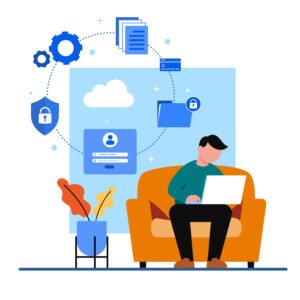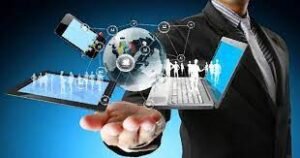In the global business arena, there are producers as sellers of products and consumers as buyers of products. These two parties are interdependent; business wouldn’t exist or succeed without either of them. Producers need consumers to purchase their products for sale, while consumers rely on producers to meet their needs. Producers sell goods in the market, and when consumers want to buy their necessities, they go to the market. This has been happening for hundreds or even thousands of years since the beginning of business when technology was not as advanced.
As technology has advanced, it has influenced the development of business systems. Currently, information technology is developing rapidly, making it difficult to avoid its progress. The advancement of information technology not only improves people’s lives every day but also supports global business. Things that were once expensive and time-consuming can now be completed in a short time. A task that would involve ten people can now involve just one. Thus, information technology has become the cornerstone of business. For example, the combination of machine learning and business intelligence can have a broad impact on the insights companies gain from available data to improve productivity, quality, customer service, and more.
Business plans have been well-known since the 1970s. This is because business plans are considered a necessary requirement for newly established entrepreneurs to obtain financing. Along with research tradition, this Business Plan is defined as a synthetic output of information collection and analytical distillation processes, including task evaluation, risk identification, strategy development, and financial planning of newly established enterprises. With all the detailed information it contains, the Business Plan soon becomes a mechanism that allows newly established enterprises to present themselves to various stakeholders by documenting how the enterprise intends to enter the market. Thus, the business plan becomes a practiced, socially accepted norm, required by investors and then internalized by entrepreneurs.
The Role of Information Technology Technology is very important in the development of companies and organizations, playing a significant role in improving the economy of a particular company. The following are the fundamental roles of information technology in a company:
Operational function makes the organizational structure leaner, and its functions are taken over by information technology. Because of its widespread use across organizational functions, units related to information technology management perform their functions as a supporting agency, where IT is considered a secure infrastructure. Supervisory and Control function. This function implies that the existence of information technology is an integral part of managerial activities inherent in the functions of each manager. Thus, the organizational structure of units related to it must be able to have a control time span or peer relationship that allows effective interaction with managers in related companies. Planning and decision function. This function is one that elevates the role of IT to be more strategic. This is because of its existence as an enabler of company business plans and a knowledge generator for company leaders faced with the reality of making several important decisions every day. It is not uncommon for companies to eventually choose to place the information technology unit as part of the company’s planning and development function. Communication function. In principle, this function is included in the firm infrastructure in the era of modern organizations, where information technology is positioned as a medium for individual company members to communicate, collaborate, cooperate, and interact. Inter-organizational function. This function is a unique role triggered by the spirit of globalization that forces companies to collaborate or partner with other companies. The concept of strategic partnerships or information technology-based partnerships, such as the implementation of Supply Chain Management or Enterprise Resource Planning. This makes companies make many significant breakthroughs in designing the structure of their information technology unit organizations. Indeed, it is not uncommon to find companies tend to outsource some business processes related to information technology management to others for the smooth running of their business. The types and functions of IT roles directly affect the design or structure of company organizational structures. It also affects the organizational structure of departments, divisions, or units related to information systems, information technology, and information management.




